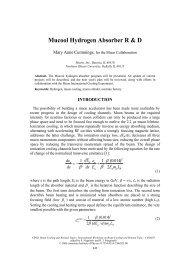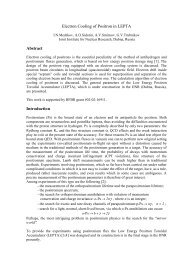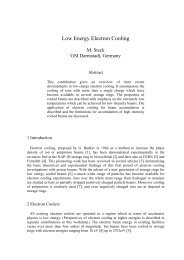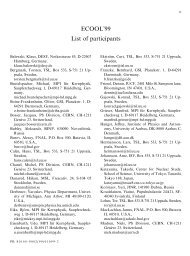Specification of a new electron cooler for the low energy ion ...
Specification of a new electron cooler for the low energy ion ...
Specification of a new electron cooler for the low energy ion ...
You also want an ePaper? Increase the reach of your titles
YUMPU automatically turns print PDFs into web optimized ePapers that Google loves.
400<br />
between <strong>the</strong> <strong>ion</strong>s and <strong>the</strong> <strong>electron</strong>s. From <strong>the</strong><br />
above relat<strong>ion</strong> one sees that a number <strong>of</strong> machine<br />
and <strong>cooler</strong> parameters can influence <strong>the</strong> cooling<br />
time. In our experiments <strong>the</strong> main points <strong>of</strong><br />
investigat<strong>ion</strong> were<br />
* The <strong>ion</strong> beam lifetime as a funct<strong>ion</strong> <strong>of</strong> <strong>the</strong><br />
<strong>electron</strong> beam intensity.<br />
* The influence <strong>of</strong> <strong>the</strong> machine lattice parameters<br />
on <strong>the</strong> cooling time.<br />
* The cooling time versus <strong>the</strong> <strong>electron</strong> beam<br />
intensity and <strong>the</strong> <strong>cooler</strong> length.<br />
* Testing <strong>of</strong> stacking modes.<br />
* Stack equilibrium emittances and emittance<br />
growth.<br />
2.1. Ion beam lifetime<br />
The lifetime <strong>of</strong> <strong>the</strong> lead <strong>ion</strong> beam in <strong>the</strong> presence<br />
<strong>of</strong> an <strong>electron</strong> beam was measured <strong>for</strong> a number <strong>of</strong><br />
charge states around 53+. An anomalously fast<br />
recombinat<strong>ion</strong> rate <strong>for</strong> Pb 53+ was observed in<br />
initial measurements and <strong>for</strong>ced us to switch to a<br />
charge state <strong>of</strong> 54+. This unusually high rate<br />
points to mechanisms o<strong>the</strong>r than radiative or<br />
di<strong>electron</strong>ic capture and has been observed at<br />
o<strong>the</strong>r heavy <strong>ion</strong> storage rings.<br />
2.2. Influence <strong>of</strong> <strong>the</strong> lattice parameters on <strong>the</strong><br />
cooling time<br />
Special importance was attached to <strong>the</strong> dependence<br />
<strong>of</strong> <strong>the</strong> cooling time on <strong>the</strong> optical parameters<br />
<strong>of</strong> <strong>the</strong> storage ring. For a given emittance<br />
and momentum spread, <strong>the</strong> lattice parameters b<br />
and D determine <strong>the</strong> size and angular distribut<strong>ion</strong><br />
<strong>of</strong> <strong>the</strong> <strong>ion</strong> beam. Cooling times were measured <strong>for</strong><br />
a wide range <strong>of</strong> lattice parameters at <strong>the</strong> <strong>cooler</strong><br />
with protons at 50 MeV and Pb <strong>ion</strong>s at 4.2 MeV/u.<br />
Contrary to what one would expect from <strong>the</strong>ory,<br />
<strong>the</strong> best cooling was obtained <strong>for</strong> intermediate b<br />
values. It should however be ment<strong>ion</strong>ed that <strong>for</strong><br />
<strong>the</strong>se machine settings a non-zero value <strong>of</strong> <strong>the</strong><br />
dispers<strong>ion</strong> funct<strong>ion</strong> was set in <strong>the</strong> <strong>cooler</strong> sect<strong>ion</strong>. It<br />
is clear that <strong>the</strong> influence <strong>of</strong> D is superimposed on<br />
<strong>the</strong> bh dependence and may even be <strong>the</strong> dominant<br />
effect.<br />
ARTICLE IN PRESS<br />
G. Tranquille / Nuclear Instruments and Methods in Physics Research A 532 (2004) 399–402<br />
Guided by <strong>the</strong>se observat<strong>ion</strong>s a series <strong>of</strong><br />
measurements were made where only <strong>the</strong> dispers<strong>ion</strong><br />
funct<strong>ion</strong> was varied and <strong>the</strong> cooling times as a<br />
funct<strong>ion</strong> <strong>of</strong> <strong>the</strong> difference in beam alignment was<br />
recorded. The results showed that with a finite<br />
dispers<strong>ion</strong> in <strong>the</strong> <strong>cooler</strong> <strong>the</strong> cooling times could be<br />
halved and, depending on <strong>the</strong> sign <strong>of</strong> <strong>the</strong> dispers<strong>ion</strong><br />
funct<strong>ion</strong>, cooling was faster <strong>for</strong> positive or<br />
negative <strong>of</strong>fsets in beam posit<strong>ion</strong>.<br />
2.3. Cooling time versus <strong>electron</strong> current and <strong>cooler</strong><br />
length<br />
In <strong>the</strong> 1997 experiments <strong>the</strong> <strong>cooler</strong> length was<br />
doubled from 1.5 to 3 m. This enabled us to<br />
complement <strong>the</strong> cooling time measurements as a<br />
funct<strong>ion</strong> <strong>of</strong> I e with <strong>the</strong> variable Z. The results show<br />
that <strong>the</strong> linear increase in cooling rate, 1/t, asa<br />
funct<strong>ion</strong> <strong>of</strong> Ie and Z shows uponly <strong>for</strong> <strong>low</strong> <strong>electron</strong><br />
currents (o120 mA). Possible explanat<strong>ion</strong>s include<br />
<strong>the</strong> effect <strong>of</strong> <strong>the</strong> <strong>electron</strong> beam space charge<br />
increasing <strong>the</strong> mean transverse velocity <strong>of</strong> <strong>the</strong><br />
beam, misalignment tolerances, which are more<br />
critical <strong>for</strong> a longer <strong>cooler</strong>, and <strong>electron</strong> beam<br />
instabilities observed at high currents due to <strong>the</strong><br />
gun design.<br />
2.4. Stacking tests and equilibrium emittances<br />
Cooling and stacking tests were per<strong>for</strong>med with<br />
<strong>the</strong> lead <strong>ion</strong> injector Linac cycling at a repetit<strong>ion</strong><br />
rate <strong>of</strong> 2.5 Hz. The <strong>ion</strong> beam was injected using a<br />
combined horizontal and longitudinal multi-turn<br />
inject<strong>ion</strong> scheme enabling upto 1.5 10 8 <strong>ion</strong>s to<br />
be injected per Linac pulse. After inject<strong>ion</strong> into <strong>the</strong><br />
ring <strong>the</strong> beam is cooled in all three planes and<br />
‘dragged’ to <strong>the</strong> stack momentum leaving space <strong>for</strong><br />
<strong>the</strong> fol<strong>low</strong>ing pulse 400 ms later. This process is<br />
repeated until <strong>the</strong> losses during <strong>the</strong> interval<br />
between consecutive pulses balance <strong>the</strong> number<br />
<strong>of</strong> particles added per inject<strong>ion</strong>. On average<br />
6 10 8<br />
<strong>ion</strong>s were accumulated in about 10<br />
inject<strong>ion</strong>s with peaks reaching 7 10 8 <strong>ion</strong>s.<br />
The stack emittance was measured as a funct<strong>ion</strong><br />
<strong>of</strong> stack intensity and <strong>the</strong> cooling was switched <strong>of</strong>f<br />
to record <strong>the</strong> emittance growth. The results show<br />
that <strong>for</strong> <strong>the</strong> required LHC intensity, <strong>the</strong> emittance,








